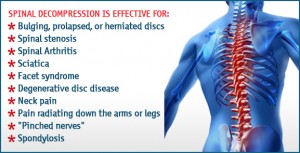Lumbar spine surgery. Spinal fusion. Disc replacement. Laminectomy. Back surgery is rarely an easy decision. Unless your condition dictates no other option, you’re likely to look for other ways to resolve your back pain and/or recover from an injury.
 And why not? If you don’t have to undergo an invasive procedure, you won’t have to worry about the potential risks: bleeding, infection, adverse reaction to anesthesia, and others. Plus, a nonsurgical option would certainly be a lot less expensive in comparison to a surgical procedure. One possible back pain solution is the spinal decompression therapy.
And why not? If you don’t have to undergo an invasive procedure, you won’t have to worry about the potential risks: bleeding, infection, adverse reaction to anesthesia, and others. Plus, a nonsurgical option would certainly be a lot less expensive in comparison to a surgical procedure. One possible back pain solution is the spinal decompression therapy.
Spinal decompression therapy, NYC residents might want to know, relieves back pain by gently stretching the spine on a traction table or any motorized device. Stretching the spine allows for change in its position and its force that leads to alleviating the pressure off the spinal discs.
The nonsurgical treatment is recommended for people who experience back pain due to disc herniation, degenerative discs, worn spinal joints (also known as posterior facet syndrome), and injured spinal nerve roots. Spinal decompression, NYC residents would want to know, is not ideal for anyone who has had unsuccessful back surgery, anyone with a spinal tumor, stenosis, or infection, anyone with advanced osteoporosis, Ankylosing spondylitis, or anyone who has already had multiple surgeries.
How does this therapy take place? First thing to note is that you will be fully clothed during the therapy. A harness will be fitted around your pelvis, plus another one around your trunk. You will then lie down — face up or face down — on a computer-controlled table. The computer will then be programmed to customize your treatment. A treatment will generally last from 30 to 45 minutes.
Typical spinal decompression therapy will comprise of 15 to 30 sessions; the number of your sessions will depend on your condition and the findings of your specialist. The costs for each session will vary.
Your specialist may also require you to do certain things before and after the sessions, like performing exercises to improve your mobility and strength and to drink a half-gallon of water daily. You’ll want to get these things in writing so that you don’t forget and you boost your chances of recovery with the nonsurgical therapy.
Back pains are not just physically agonizing, but they can also prevent you from doing what it is you love to do every day. When you’ve got an opportunity to go with a non-invasive treatment, ask your spinal specialist about spinal decompression. And you can maybe start your journey to pain-free days.














